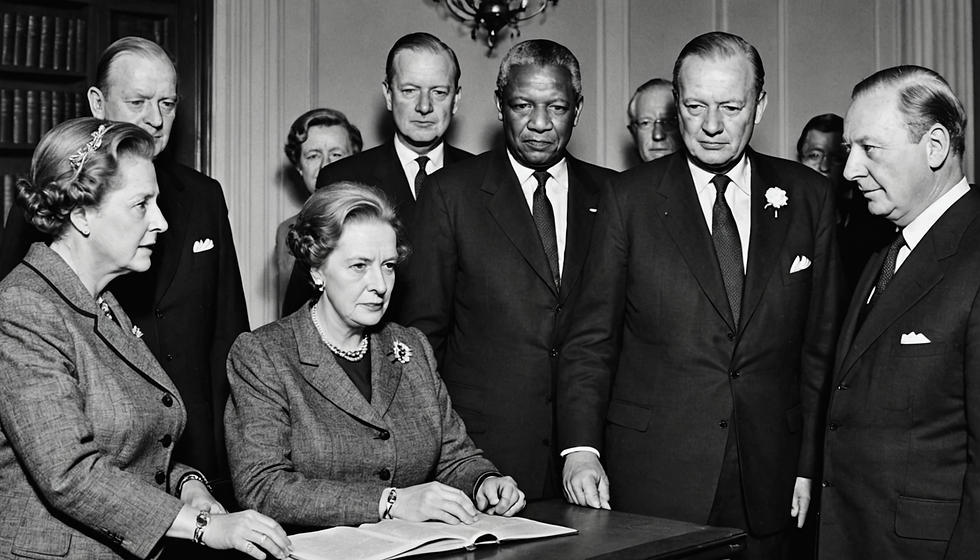6 Weapons of influence: Before & in negotiations
- R.M. Boylan

- Feb 13
- 5 min read
Updated: Mar 9
The Psychology of Influence: Cialdini

6 Weapons of influence: Before & in negotiations
Psychology of Influence
How can we leverage the psychology of persuasion to deliver results while maintaining integrity?
In an era of digital censorship and control, influence can become a dirty game. Those with wealth, status and privilege control the influence cascade. However, for those with integrity the 6 weapons of influence are still relevant. The process is slower however when AI/digital technology is being used to insulate or censor the person/group/organization. But these principles still hold true.
Robert B. Cialdini authored a national best seller titled “Influence: The Psychology of Persuasion.” In a market perceived as "me-too," where numerous products vie for attention, I believe it's crucial to be diverse instead of dull or predictable. However, there must still be a shared element among the general audience, or the message risks being diluted or lost.
For marketers, this book might have been among one of the best written in a decade at the time of its release. It contains several principles that I enjoy applying and teaching to salespeople and negotiators. I frequently used these principles, particularly authority and expertise, in market access to demonstrate the integrity of a medicine linked to solving key issues for unmet medical needs. I consider this approach to be one of the most ethical.
I appreciate the concept of "authority," which involves using solid clinical evidence, expertise, and connections to experts who can validate with integrity/ethics the evidence. I also value "scarcity," the idea that something becomes more valuable when it is rare. Additionally, I believe in "reciprocity," the act of returning favors, and "liking" as long as it is not bribery, obstructing justice or corruption.
I don't see it as a method to manipulate others, although some individuals might misuse the principles. If our personal brand makes us blend in with everyone else, we should think about using influence tools so that our customers are eager to see us and hear our message. I suppose these tools are meant to make people desire more of our product and/or us and what we contribute to their lives.
In his exploration of human persuasion, Cialdini identified six principles that guide how we influence others in personal relationships, marketing, sales, and market access. Utilizing these principles and comprehending the influence dynamics within a business model is crucial for fostering influence and behavioral change. When examining how politicians campaign for elections, they seldom employ all these techniques to gain supporters. They predominantly rely on "social proof," "liking," and, ideally, "Commitment & Consistency."
In Cialdini’s work he cites there are several different principles of influence at our disposal. They include:
1). Reciprocity 2). Commitment & Consistency 3). Social Proof 4). Liking 5). Authority and 6). Scarcity.
When we think about the “cascade of influence” what comes to mind? How many of the above principles do people leverage to influence others? Most people only function on "liking". We act polite, friendly and deliver a marketing message the same way everyone like us does. That may afford us some time with a customer, but it may not change their behaviour. Time is our customer's most scarce commodity, we need to bring value or something different in presence, expertise and/or style.
Understanding the Psychology of Influence:
1). Reciprocity
“The old give & take”. There have been studies done on reciprocity. This is one of the most powerful forms of influence. The rule states that we should as humans try to repay in kind, kind gestures. “By virtue of the reciprocity rule, humans feel obligated to the future repayment of favours, good service, kind deeds done without personal gain so much so that we have replaced the term ‘much obliged’ with ‘thank you’ in many languages. What is impressive about “reciprocity” is it is pervasive across all human cultures. That includes physicians if we help them help their patients." (Cialdini, R. 2007).
2). Commitment & Consistency
“A Canadian study revealed that persons at the racetrack are much more confident after they placed the bet that their horse would win than before. It is the same horse, the same track, the same field, nothing changed.” (Cialdini, R. 2007). Yet their confidence to commitment and consistency increased just by putting their bet into reality. This is our desire to be and to appear consistent with what we have already done. For this reason customers who hold certain views about products and their use may be difficult to change. Understanding this law of influence can help us.
3). Social Proof
'Laugh tracks are annoying to everyone, yet people laugh at things they may not find funny because they are programmed to do so. Experiments have demonstrated that it works despite how ridiculous we all know it is. Social proof is what we do and how we act that we believe is consistent with what others find correct. "(Cialdini, R. 2007)
Ensuring we introduce new concepts that associate with other accepted modes of conduct and what is considered to be right is an important stage for moving customers and/or followers to trusting you. All persons have a “ tendency to see things and behave in manners that are consistent with what their peers believe is correct.” (Cialdini, R. 2007). Even if it is incorrect.
As a result of “social proof” pressure, customers can be easily convinced and fooled by fake evidence. That is when the rule of “Authority” for influence may be helpful to change behaviour and perception.
4). Authority
When we follow an expert, we feel better about the decisions we make. For products in the biosciences channeling the rules of influence with data, research, evidenced based information & credibility is paramount to convincing others that what you have is credible, represents integrity. People naturally trust authority figures on subjects, sometimes irrespective of available research & outcomes.
Understanding how to influence this cascade of association is very useful. Physicians who are considered too involved in pharmaceutical relations dilute their authority and credibility. If someone of Authority on a subject supports you and/your product you are in a good position.
5). Liking
We are naturally more responsive to people who are like us, than not. We generally as humans respond to persons who we know and like. It is the law of similarity. Whether right or wrong it is a reality. When we are not similar to our customer and or employees it is important to find common ground so they feel safe with us. Stephen Covey wrote a book called the “Speed of Trust” and trust for some reason is personified in “similarity”.This is especially critical in sales and in using the psychology of influence. If we look at how women sold Tupperware at parties it was based on the rule of liking and similarity. It worked. (Cialdini, R. 2007).
6). Scarcity
Apple is particularly skilled at this principle. G.K. Chesterton said “The way to love anything, is to realize that it might be lost.” In this principle sellers and marketers build up the value as a plausible scarce resource. Back orders create a heightened response in the human brain which triggers impulsivity.
While our product may not be scarce, our approach in sales and creating interest may be, making your presence a refreshing perspective and energy to your customer and/or employees day. If we are well differentiated in our market based on the service to customers we provide, we have mastered the art of “Scarcity” in sales using our personae/presence as a lever to ensure customers actually want to spend time with you.
References:
Cialdini, R.B. (2007). Influence: The psychology of Persuasion.
Boylan, R.M. (2006-2009). Conflicts and considerations comparing Abraham Maslow's hierarchy of needs to Jane Loevinger's model of ego development for assessing the level of development of a leader. M.A. Leadership Studies.





Comments